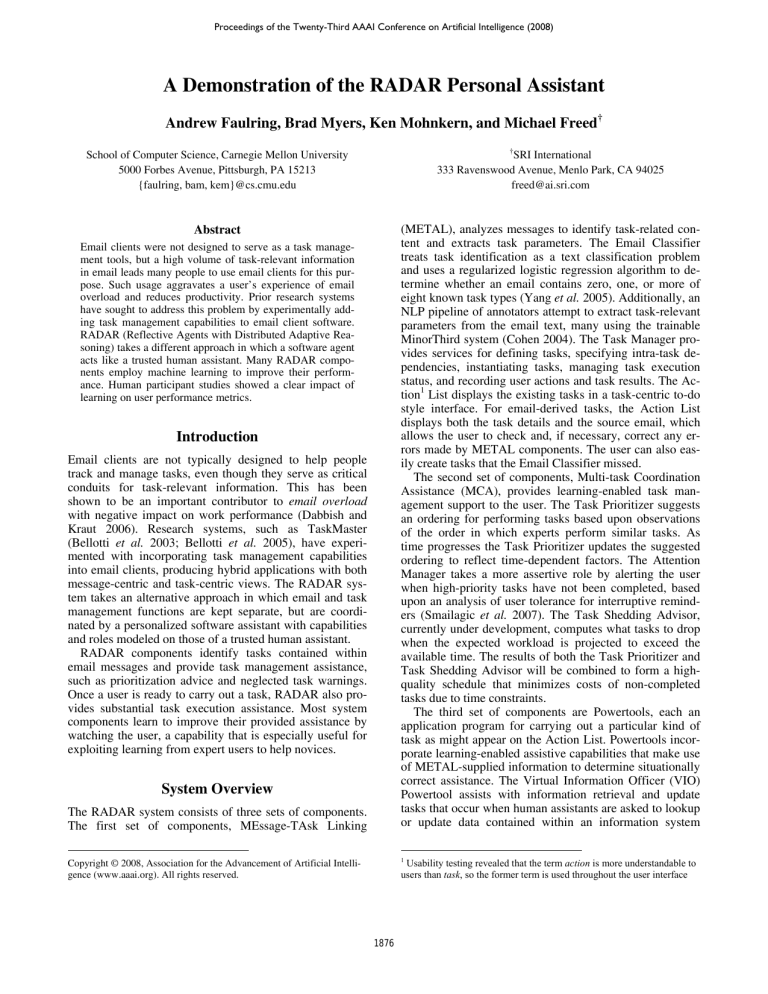
Proceedings of the Twenty-Third AAAI Conference on Artificial Intelligence (2008)
A Demonstration of the RADAR Personal Assistant
Andrew Faulring, Brad Myers, Ken Mohnkern, and Michael Freed†
†
School of Computer Science, Carnegie Mellon University
5000 Forbes Avenue, Pittsburgh, PA 15213
{faulring, bam, kem}@cs.cmu.edu
SRI International
333 Ravenswood Avenue, Menlo Park, CA 94025
freed@ai.sri.com
Abstract
(METAL), analyzes messages to identify task-related content and extracts task parameters. The Email Classifier
treats task identification as a text classification problem
and uses a regularized logistic regression algorithm to determine whether an email contains zero, one, or more of
eight known task types (Yang et al. 2005). Additionally, an
NLP pipeline of annotators attempt to extract task-relevant
parameters from the email text, many using the trainable
MinorThird system (Cohen 2004). The Task Manager provides services for defining tasks, specifying intra-task dependencies, instantiating tasks, managing task execution
status, and recording user actions and task results. The Action1 List displays the existing tasks in a task-centric to-do
style interface. For email-derived tasks, the Action List
displays both the task details and the source email, which
allows the user to check and, if necessary, correct any errors made by METAL components. The user can also easily create tasks that the Email Classifier missed.
The second set of components, Multi-task Coordination
Assistance (MCA), provides learning-enabled task management support to the user. The Task Prioritizer suggests
an ordering for performing tasks based upon observations
of the order in which experts perform similar tasks. As
time progresses the Task Prioritizer updates the suggested
ordering to reflect time-dependent factors. The Attention
Manager takes a more assertive role by alerting the user
when high-priority tasks have not been completed, based
upon an analysis of user tolerance for interruptive reminders (Smailagic et al. 2007). The Task Shedding Advisor,
currently under development, computes what tasks to drop
when the expected workload is projected to exceed the
available time. The results of both the Task Prioritizer and
Task Shedding Advisor will be combined to form a highquality schedule that minimizes costs of non-completed
tasks due to time constraints.
The third set of components are Powertools, each an
application program for carrying out a particular kind of
task as might appear on the Action List. Powertools incorporate learning-enabled assistive capabilities that make use
of METAL-supplied information to determine situationally
correct assistance. The Virtual Information Officer (VIO)
Powertool assists with information retrieval and update
tasks that occur when human assistants are asked to lookup
or update data contained within an information system
Email clients were not designed to serve as a task management tools, but a high volume of task-relevant information
in email leads many people to use email clients for this purpose. Such usage aggravates a user’s experience of email
overload and reduces productivity. Prior research systems
have sought to address this problem by experimentally adding task management capabilities to email client software.
RADAR (Reflective Agents with Distributed Adaptive Reasoning) takes a different approach in which a software agent
acts like a trusted human assistant. Many RADAR components employ machine learning to improve their performance. Human participant studies showed a clear impact of
learning on user performance metrics.
Introduction
Email clients are not typically designed to help people
track and manage tasks, even though they serve as critical
conduits for task-relevant information. This has been
shown to be an important contributor to email overload
with negative impact on work performance (Dabbish and
Kraut 2006). Research systems, such as TaskMaster
(Bellotti et al. 2003; Bellotti et al. 2005), have experimented with incorporating task management capabilities
into email clients, producing hybrid applications with both
message-centric and task-centric views. The RADAR system takes an alternative approach in which email and task
management functions are kept separate, but are coordinated by a personalized software assistant with capabilities
and roles modeled on those of a trusted human assistant.
RADAR components identify tasks contained within
email messages and provide task management assistance,
such as prioritization advice and neglected task warnings.
Once a user is ready to carry out a task, RADAR also provides substantial task execution assistance. Most system
components learn to improve their provided assistance by
watching the user, a capability that is especially useful for
exploiting learning from expert users to help novices.
System Overview
The RADAR system consists of three sets of components.
The first set of components, MEssage-TAsk Linking
Copyright © 2008, Association for the Advancement of Artificial Intelligence (www.aaai.org). All rights reserved.
1
Usability testing revealed that the term action is more understandable to
users than task, so the former term is used throughout the user interface
1876
(Zimmerman et al. 2007). Processing a request typically
involves reading the email and then locating, completing,
and submitting a form corresponding to the expressed intent. VIO uses machine learning algorithms to suggest the
appropriate form and fill in its fields. The SpaceTime
Planner (STP) and the CMRadar Powertools are used to
schedule complex events (such as a conference). STP incorporates a new optimization algorithm designed for
mixed-initiative allocation with uncertainty (Fink et al.
2006). CMRadar learns regularities in the environment,
such as the likelihood of success in seeking new resources,
that suggest ways to relax STP planning problems and
thereby produce better solutions (Oh and Smith 2004). The
Briefing Assistant Powertool assists users in authoring
status reports that summarize what has and has not yet
been accomplished (Kumar et al. 2007).
Conclusion
The RADAR system represents a new approach to handling email overload: a trusted human assistant that aids a
user with both task management and task execution.
Acknowledgments
The authors thank the numerous faculty, staff, and students
at Carnegie Mellon University, SRI International, and elsewhere, who have worked to design and build RADAR.
This material is based upon work supported by the Defense
Advanced Projects Research Agency (DARPA) under
Contract No. FA8750-07-D-0185.
References
Evaluation
Bellotti, V. et al. 2003. Taking Email to Task: The Design
and Evaluation of a Task Management Centered Email
Tool. Proc. of CHI, 345–352. ACM Press.
As a multi-year project under DARPA’s Personalized Assistant that Learns (PAL) program, RADAR is evaluated
annually to measure machine learning research progress
with particular focus on learning in the wild: learning
based on passive observations or natural interaction with a
user. A brief overview of the evaluation follows; a full
description of the test design and evaluation procedures is
described elsewhere (Steinfeld et al. 2007). The participant’s overall task is to take over organizing a fictional
academic conference, substituting for an incapacitated organizer. Participants are instructed to go through the organizer’s email inbox (119 messages) to learn what else needs
doing and come as close as possible to completing the remaining tasks. Participants are given approximately two
hours of instruction, including some hands-on training using the RADAR system, followed by two hours of testing.
In one condition, participants use a version of RADAR that
had undergone a period of simulated use, allowing learning
mechanisms to train the system with the goal of improving
performance. We refer to this condition as RADAR +
Learning (“Radar +L”). In a second condition, participants
use an untrained version of RADAR (“RADAR −L”) to
provide a baseline measure of performance. This design
shows how well RADAR’s machine learning assists a participant independent of any engineered functionality or
knowledge. An overall scoring function calculates performance on the conference planning task, yielding a score
between 0.000 and 1.000. Results (see table below) show
that, for the most recent test (Year 3), learning algorithms
improved user performance by 32%, with the contribution
of learning increasing by 41% from Year 2 to Year 3.
Condition
Year 2
N
Score
Year 3
N
Score
RADAR −L
18
0.509
42
0.534
RADAR +L
18
0.630
32
0.705
Bellotti, V. et al. 2005. Quality Versus Quantity: E-MailCentric Task Management and Its Relation With Overload.
Human-Computer Interaction 20(1/2): 89–138.
Cohen, W.W. 2004. Minorthird: Methods for Identifying
Names and Ontological Relations in Text using Heuristics
for
Inducing
Regularities
from
Data.
http://minorthird.sourceforge.net/.
Dabbish, L.A.; and Kraut, R.E. 2006. Email Overload at
Work: An Analysis of Factors Associated with Email
Strain. Proc. of CSCW, 431–440. ACM Press.
Fink, E. et al. 2006. Scheduling with Uncertain Resources:
Search for a Near-Optimal Solution. Proc. of IEEE SMC,
137–144. IEEE Press.
Kumar, M. et al. 2007. Summarizing Non-textual Events
with a ‘Briefing’ Focus. Proc. of RIAO, Centre De Hautes
Etudes Internationales D'Informatique Documentaire.
Oh, J.; and Smith, S.F. 2004. Learning User Preferences in
Distributed Calendar Scheduling. Proc. of PATAT, 35–50.
Smailagic, A. et al. 2007. Task Interruptibility Analysis.
Technical Report, Institute for Complex Engineered Systems, Carnegie Mellon University, Pittsburgh, PA.
Steinfeld, A. et al. 2007. Evaluation of an Integrated MultiTask Machine Learning System with Humans in the Loop.
Proc. of PerMIS, NIST.
Yang, Y. et al. 2005. Robustness of Adaptive Filtering
Methods in a Cross-Benchmark Evaluation. Proc. of
SIGIR, 98–105. ACM Press.
Zimmerman, J. et al. 2007. VIO: A Mixed-initiative Approach to Learning and Automating Procedural Update
Tasks. Proc. of CHI, 1445–1454. ACM Press.
1877









